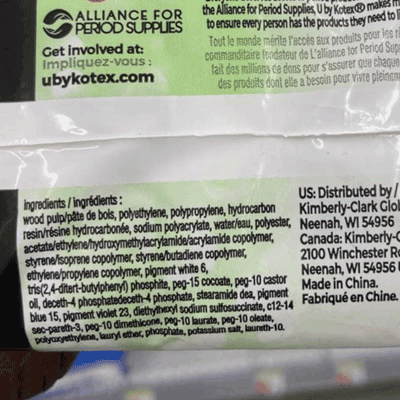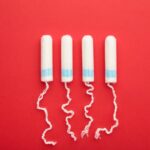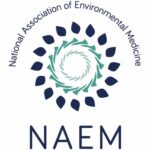We Now Have More Information about Ingredients Used in Period Products Than Ever Before!
Do you have concerns about titanium dioxide in tampons and pads?
WVE’s Director of Science and Research, Alex Scranton, addresses your questions in her recent episode of #AskAlex. Learn more and watch video here!
—————————————————————————–
 |
| Alex Scranton Director of Science and Research |
At Women’s Voices for the Earth, we have been working towards safer and healthier period products for almost ten years now. And in all that time we have consistently been asking – what kinds of chemical exposures are created by using period products, and how are they affecting our health? And these have been very hard questions to wrestle with for the simple reason that we did not have complete information on what these products are actually made of.
Such a simple ask of companies – just tell us what your products are made of! We put these products on and in our bodies monthly over decades of our lives and we deserve to know what is in them. We did get some companies to voluntarily provide ingredient information a few years back – but it turns out we still were not getting the full picture. They weren’t actually telling us everything that is included in their products. Finally, we worked to pass a law in New York state in 2019, which legally requires that all companies selling products in the state disclose their ingredients on the label. This law went into effect in October 2021. So we went and had a look at the results. Actually, a number of YOU helped us enormously by going to your local store and taking photos of product labels and sharing them with us. (We LOVE our volunteer researchers! Thank you!) And we compiled the results of that field study in our latest report “What’s in Your Period Product?” available here.
So what did we find?
It turns out that having a law requiring disclosure helps a lot. Most of the label pictures we got back had ingredient listings! This is a world of difference from just a year or two ago when this was relatively rare to find on a package. We strongly encourage you to check out these new labels on your own products! And this was true both in New York state as well as other places around the country where labeling ingredients isn’t required by law. (Thanks, New Yorkers!) Every period product user is getting way more information about these products than ever before. Even the brands that were previously disclosing ingredients on their websites, are now revealing that often there are even more ingredients, additives, coatings etc. that they failed to tell you about before. Some period products are a lot more complicated than we ever knew, which has led to some surprise findings.
Take for example, what you might expect is just a simple tampon. (Truth be told – these do exist – by simple tampons I mean basically the only ingredient in the whole product is cotton.)
But check out the ingredients in other tampons and you might find:
- a cotton or rayon absorbent core,
- surrounded by a polyethylene (read, plastic) sheath,
- which is coated with glycerin and/or PEG 100 Stearate to help the fibers wick fluid,
- and infused fragrance ingredients like dihexyl fumerate or ethylene brassylate
- and titanium dioxide to make it look whiter
- add to that a polyester string, (yep more plastic)
- dyed with Disperse blue 60 colorant
- and coated in a petrochemical paraffin wax.
Wow! It’s a much more complicated exposure than just cotton. And I could find very little research that can tell us about the safety of vaginal exposures to these kinds of chemicals. I can’t tell you that I know these chemicals are bad for vaginal health, because they just haven’t been studied. But I am concerned about how some of these exposures may be affecting us.
Menstrual pads get even more complicated with top layers, middle layers of absorbent foam, super absorbent polymers, various waterproof backings, more fragrance, lots of coatings to wick fluid and aid absorption, lotion ingredients like petrolatum, adhesives made with styrene, more titanium dioxide to make it look whiter, as well as colored dyes for pretty designs. All in all, in pads – our field study found 75 unique ingredients disclosed across different brands, that we had never been told about before. And again – very little research assuring the safety of these chemicals on vulvar and vaginal health.
And really this is still the beginning of what we would still like to know. Even well-intended laws are not perfect – and lots of companies are still not totally getting the memo on what information they must provide to users. We found some products are not disclosing ingredients at all. Other products were more selective, disclosing some but not all ingredients. Lots of products were just really vague – listing ingredients like “surfactant” “ink” or “adhesive”. You just can’t get away with that on ingredient labels for food or personal care products, and there’s no reason we should expect this inadequate disclosure for period products. Thankfully we did find some good examples too, products that were pretty transparent about their ingredients – so we know it can be done.
As we gather more information – we will be digging further into what we know about all these recently disclosed chemicals in period products. We will be asking companies more questions about their choice of chemicals, and what science they have to justify their use. Meanwhile, check out our report to see some photos of what these new labels look like (the good and the bad), the list of newly disclosed chemicals we identified, and our initial recommendations on how to use this information to find safer and healthier period products that work for you and your body.
And stay tuned – there is still lots to do – and we will need your help and your voices more than ever!
————————————————






